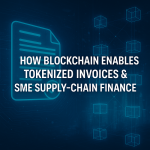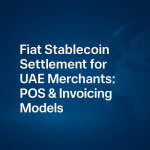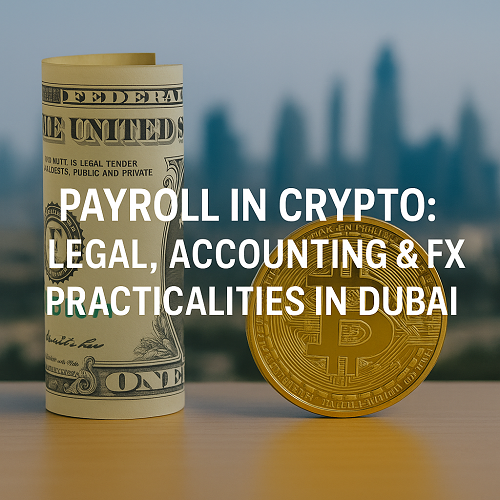Introduction
As Dubai strengthens its position as a global hub for virtual assets, more startups and scaleups are exploring crypto payroll to compensate employees and contractors in stablecoins or tokens. The pitch is compelling: faster cross-border settlement, transparent records, and cultural alignment with Web3-native teams.
But making crypto payroll in Dubai work requires careful choreography: labour law and WPS rules, payment-token licensing, IFRS-aligned accounting, FX risk management, AML/Travel Rule compliance, and employee education. This guide details the operating models, controls, and documentation you’ll need to run token-denominated payroll safely and responsibly in the UAE.
BREAKING:
Dubai officially approves Bitcoin & crypto for salary payments. pic.twitter.com/taCRhr4gl9
— Globe Eye News (@GlobeEyeNews) August 17, 2024
Why crypto payroll is gaining ground in Dubai
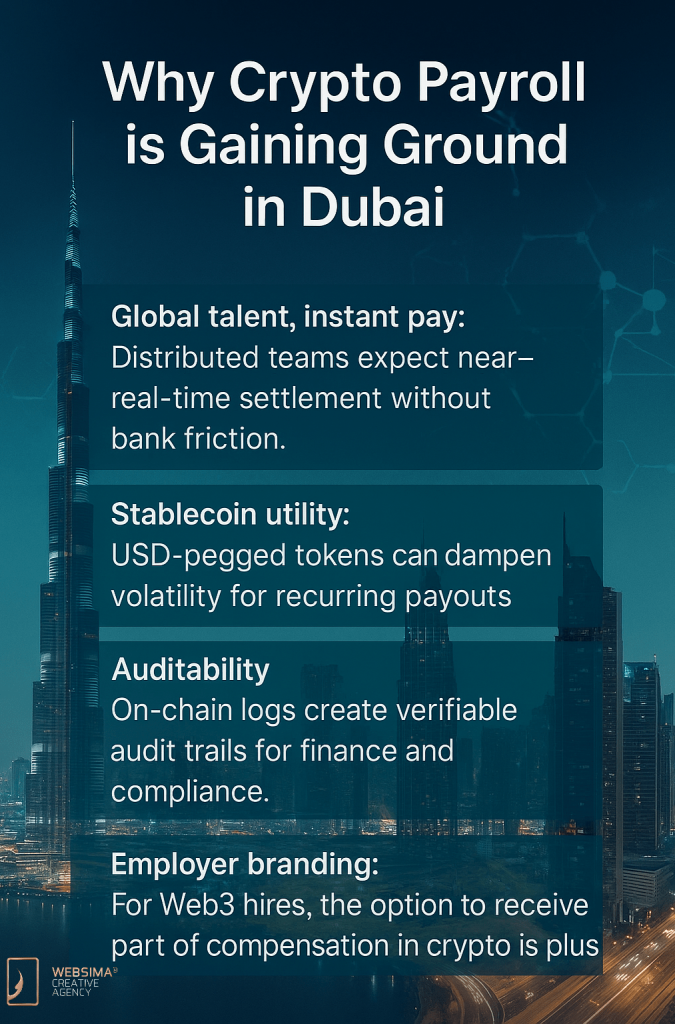
- Global talent, instant pay: Distributed teams expect near-real-time settlement without bank friction.
- Stablecoin utility: USD-pegged tokens can dampen volatility for recurring payouts.
- Auditability: On-chain logs create verifiable audit trails for finance and compliance.
- Employer branding: For Web3 hires, the option to receive part of compensation in crypto is a plus.
Common initial targets: remote engineers and designers abroad, performance bonuses for on-shore staff, and contractor networks paid in stablecoins.
Legal context: what UAE law actually allows
WPS remains the baseline for on-shore employees
Under the UAE’s Wage Protection System (WPS), salaries for private-sector employees must be routed through approved financial channels in legal tender. That means base salary for on-shore staff still runs through WPS in AED; crypto cannot replace it today. See the government’s overview of wage payment rules on the UAE official portal (hyperlink below).
- Link: Payment of salaries/wages – UAE Government Portal (WPS overview and compliance) → official portal page
Court precedent for partial crypto remuneration
A 2024 Dubai Court of First Instance judgement confirmed part of an employee’s remuneration may be paid in cryptocurrency, provided it’s clearly stipulated contractually; it does not override WPS for base salary.
- Link: Dubai court: crypto as a supplementary element of salary → Morgan Lewis analysis
Token rails must be licensed
If your payroll flow involves issuance, custody, conversion, or transfer of payment tokens directed at UAE persons, it must run through a licensed Payment-Token Service under the Central Bank’s Payment Token Services Regulation (PTSR).
- Link: CBUAE Payment Token Services Regulation (PTSR) → CBUAE Rulebook
Practical takeaway: the hybrid model is the compliant default today—WPS in AED for base pay; crypto for bonuses, overseas contractors, or equity-like incentives, routed via a licensed provider.
Accounting & reporting: getting the numbers right
Fair-value measurement at the time of payment
Under IFRS, crypto assets generally fall under intangible assets (IAS 38). For payroll, you must recognize the expense at fair market value at the time of disbursement in AED terms, with gains/losses on treasury holdings reflected appropriately.
Documentation finance will ask for
- On-chain proofs (transaction hashes, wallet addresses)
- Timestamped market rates used for valuation
- Employee agreements and opt-in records
- Reconciliation of AED payroll ledger to token disbursements
Audit readiness
Automate evidence capture: exportable CSVs of transactions, linked hashes, FX snapshots, and signed employee consents. Forward-plan for corporate tax (9%) on realized gains from token inventory movements.
FX & volatility: protecting both employer and employee
Cross-border payroll automation increasingly mirrors blockchain remittance dApp architectures that handle FX conversion and settlement across worker corridors. Even with stablecoins, the treasury needs policies that remove price surprises between “gross in AED” and “net paid in tokens.” Use a playbook like this:
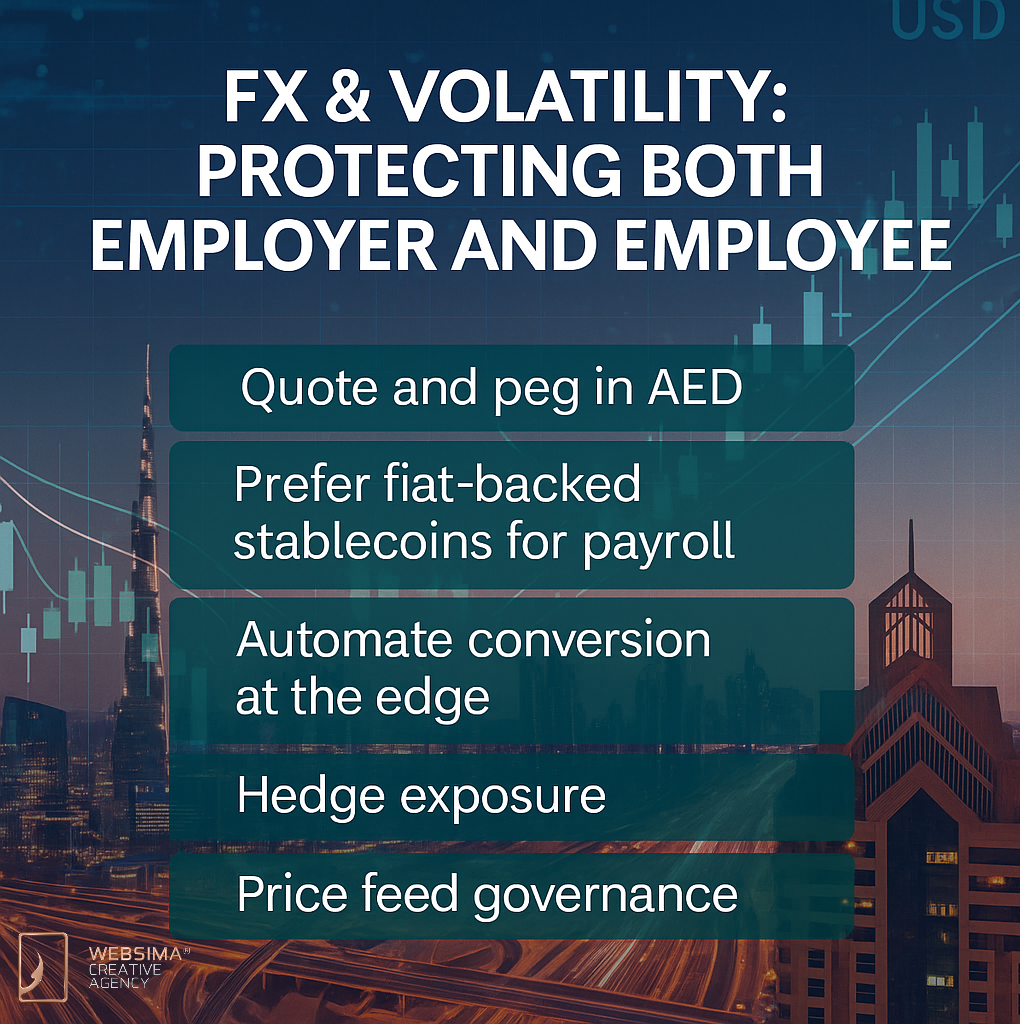
- Quote and peg in AED
Contract and gross pay remain AED-denominated. The crypto amount is computed at execution time from a price oracle. - Prefer fiat-backed stablecoins for payroll
Reserve volatile assets (BTC/ETH) for long-term incentives, not monthly salary. - Automate conversion at the edge
Use a licensed desk to convert just-in-time, reducing inventory risk. - Hedge exposure
If you pre-fund treasury, consider forwards or options on major pairs. - Price feed governance
Define which price source, update interval, and deviation thresholds are acceptable.
- Link: How to source robust on-chain price data for conversions → Chainlink Data Feeds docs
AML, Travel Rule & data privacy
Cross-border payroll automation increasingly mirrors blockchain remittance dApp architectures that handle FX conversion and settlement across worker corridors. Crypto payroll crossing borders must respect AML/CFT standards and the Travel Rule (transmitting originator/beneficiary info for qualifying transfers). UAE regulators continue to align with FATF standards; ensure your provider can share or attest Travel Rule data without breaking UX.
- Link: FATF Travel Rule & VA/VASP guidance (2025 update) → FATF update on Recommendation 16
For privacy, apply UAE PDPL principles: collect the minimum, store sensitive metadata off-chain, and minimize any direct link between named employees and public wallet addresses.
Implementation playbook (step-by-step)
1) Define your operating model
- On-shore employees: base AED via WPS; optional crypto bonus.
- Off-shore contractors: crypto eligible by default.
- Advisors/ambassadors: milestone-based token grants.
2) Select the rails
- Licensed payment-token provider in UAE (PTSR compliance).
- Approved stablecoins only.
- Segregated corporate wallets with policy controls and multisig.
3) Write clear compensation language
- AED is the unit of account; crypto shown as a computed amount at payment time.
- State price source, timestamp, and tolerance for deviations.
- Include opt-in/opt-out and country-specific tax clauses.
4) Build the treasury flow
- USDC/USDT funding method, daily conversion window, rate caps.
- Role-based approvals for disbursements.
- Emergency “pause” switch for depeg or provider outage.
5) Integrate with finance
- Automated export of hashes + valuation snapshots.
- Monthly reconciliation pack for auditors.
- Corporate-tax treatment for realized gains.
6) Production-grade controls
- Key management (HSM/MPC), access logs, spend limits.
- Counterparty SLAs and attestation of licensing.
- Incident response runbook for lost keys, wrong-address, or depeg.
Case study (composite): DMCC startup with remote team
A DMCC-incorporated analytics startup employs 22 remote engineers across Europe and Asia, plus 6 on-shore staff. The company:
- Pays base salaries for on-shore staff via WPS in AED.
- Pays monthly performance bonuses and all off-shore contractors in USDC through a licensed UAE provider.
- Pegs all calculations to AED with just-in-time conversion using an auditable price feed.
- Exports transaction hashes and FX snapshots into its ERP on close.
Results after 2 quarters: payroll cycle time fell from 4–5 days to under 1 hour; FX leakage dropped by ~1.5%; and audit prep moved from week-long sprints to a single automated reconciliation pack.
Common pitfalls & how to avoid them
- Trying to replace WPS completely with crypto
Keep AED base pay via WPS; add crypto as a supplementary element. - Unlicensed rails
Only operate through a CBUAE-recognized payment-token service. - Pricing with a single, opaque source
Use an auditable oracle configuration and document it. - Token hoarding
JIT converts to fund payroll; hedge longer balances. - Poor employee onboarding
Provide a clear FAQ: custody options, exchange risks, and local tax considerations for their country of residence.
Policy templates (grab-and-go)
Offer letter clause (excerpt):
“Your base remuneration is AED-denominated and paid through WPS. Subject to your written opt-in, a discretionary portion of your compensation may be settled in approved payment tokens. The crypto amount will be calculated using the Company’s designated price source at the timestamp of payment, with a maximum ±X% deviation threshold.”
Treasury SOP (excerpt):
- Stablecoin: USDC primary, USDT secondary (board-approved).
- Price source: documented oracle feed; snapshot attached to payroll batch.
- Conversion window: 09:30–10:00 GST; limits set by CFO.
- Emergency halt if token deviates >Y% from peg or provider SLA breached.
Outlook: what changes next
- Stablecoin-ready rails: Expect broader institutional rails compatible with WPS-adjacent flows as regulation matures.
- CBDC settlement: Digital Dirham could enable fiat-on-chain payroll with central-bank oversight—eliminating conversion slippage and counterparty risk.
- Automated treasury: Smart-contract payroll that auto-converts, disburses, and books the journal entry.
- Global reporting: As major economies adopt standardized crypto reporting frameworks, audit-ready artefacts will become table stakes.
FAQs
Can I pay employees entirely in crypto?
For on-shore staff, no—base salaries run through WPS in AED. Crypto can be a supplementary component if contractually agreed.
Are crypto bonuses legal?
Yes, when clearly defined in the employment agreement and processed through licensed rails; see the 2024 Dubai judgment confirming partial remuneration in crypto.
What stablecoin should we use for payroll?
Choose fully asset-backed tokens supported by a licensed payment-token provider and document your selection and monitoring criteria.
How do I manage volatility?
Peg in AED, convert just-in-time, and hedge any balances held beyond the payroll window.
What AML/Travel Rule steps apply?
Use rails that can transmit required originator/beneficiary data for cross-border transfers in line with FATF’s updated Recommendation 16.
Work with Websima
We help UAE companies deploy compliant crypto payroll: hybrid WPS + stablecoin flows, licensed rails, IFRS-aligned reporting, and FX/treasury automation. If you’re moving from pilot to production, we’ll design the policy stack, integrations, and controls to make it smooth for Finance, HR, and auditors.
→ Talk to us at Websima: https://websima.ae/contactus/

